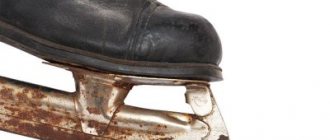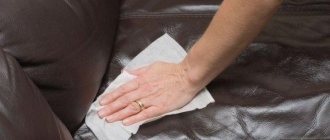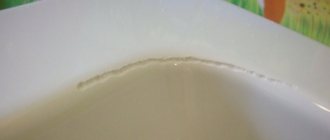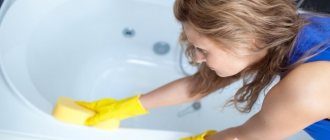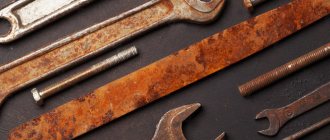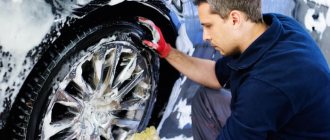Metal oxidation occurs when exposed to moisture and oxygen. As a result, a reddish-brown coating forms, which over time destroys the material.
To eliminate corrosion, not only purchased products can be used, but also simple home recipes.
Read the article about how to remove rust from metal at home using folk remedies.
How to clean the surface?
To achieve a good result, rust removal must combine an integrated approach: mechanical and chemical action.
Just cleaning off the rusty layer is not enough. Chemical exposure prevents the spread of corrosive processes.
In addition, electrochemical effects can be used by passing an electric current through a special solution. This method is used more often in industrial settings, but can also be organized at home, despite the complexity of the organization.
You will find all the most useful and important information about rust removal methods and techniques in this section.
Acids
Let's look at what acids remove rust:
Lemon
Citric acid is a harmless product that will help deal with rust stains on metal, as well as on tiles and other surfaces.
At the preparation stage for cleaning, the acid is diluted with water, preparing a concentrated solution, and applied to the affected areas .
After the composition has been applied for an hour, the acid is washed off with a washcloth. This option is suitable for light stains, but will not cope with serious ones.
Read more about the use of citric acid in the fight against rust here.
Sorrel
Oxalic acid is a chemical substance that exhibits corrosion activity. This drug is effective, but poisonous. Its use must be carried out with high-quality protection, including safety glasses and a respirator. Can be used for advanced cases.
Work order:
- wash the area that needs treatment with a detergent; even laundry soap will do;
- dry the metal;
- Combine 0.3 liters in a separate container. water and 6 tsp. acid powder;
- apply the product with a brush;
- ensure contact of the solution with the metal for 40 minutes;
- clean with a brush;
- rinse under water.
If possible, it is better to clean metal items by immersion in the prepared solution.
Solyanaya
You can remove rust from metal using hydrochloric acid. This method gives a good effect, allowing you to cope with even advanced cases of corrosion.
Work order:
- With a rag soaked in acid, rub the surface with areas of corrosion using polishing, rubbing movements.
- Leave for half an hour.
- Wash off with plenty of water.
You need to wash off the acid especially carefully so that it does not remain on the metal at all, since it can damage the skin of your hands, even in low concentrations. It is necessary to take into account the toxicity of the drug and pay attention to personal protection.
Orthophosphoric
Phosphoric acid is one of the most effective substances for removing corrosion on metal. Due to its ability to react with corrosion products, this drug can cope with even significant damage.
To clean the metal, an acid of 15-20% concentration is used. The time required for exposure is about 5 minutes. After this, the remaining rust is cleaned off with a stiff brush.
Phosphoric acid is included in most rust converters. This article will tell you about the use of phosphoric acid against rust.
Vinegar
Removing rust using vinegar is a simple method that does not require significant investment. But this method will give a good effect only with unstable contamination in domestic conditions, for example, on plumbing.
The best results will be if the rusted metal objects are small and can be completely dipped in vinegar. This method is convenient for bringing bolts, nuts, etc. into proper shape.
It is recommended to use vinegar undiluted. Read more about the cleaning method here.
Soda
Baking soda is an affordable product for combating rusty plaque at home.
To prepare the cleaning composition, you need to make a non-liquid mixture, the consistency of which is like gruel.
Operating procedure:
- Using a sponge, apply the composition to the area of contamination using rubbing movements.
- The mixture is left to act for half an hour.
- Rub the metal again with a sponge or brush.
- Rinse off.
Hydrogen peroxide
Peroxide is a cheap pharmaceutical product used to disinfect wounds. In addition, this drug is actively used to remove dirt from various surfaces, and also helps to cope with rust.
You can use peroxide as a stand-alone product or in combination with sodium salt, which can increase the effect.
Procedure:
- pour 4 tbsp into the prepared container. trisodium phosphate;
- pour in 3 liters of water;
- pour in 50 ml of peroxide very slowly, in small portions;
- Dip rusted tools or other metal objects into the container;
- leave the metal in the solution for half an hour;
- wash off the composition with water.
For large objects, active rubbing of the metal surface with a solution is acceptable. Periodically, several times, every 10 minutes, repeat rubbing.
It is convenient to use peroxide to combat corrosion if it is present in small quantities , for example, on kitchen utensils.
Aluminium foil
Aluminum foil, which is used in the kitchen during food preparation, can be used for an abrasive effect.
To do this you need:
- Cut off a small piece of foil.
- Form this piece into a ball.
- Use this ball to treat rust stains using rubbing movements.
This method can be used to treat small stains, but it is not suitable for eliminating serious corrosion damage. Treatment with foil gives an unstable result.
This method is suitable as a temporary measure , if necessary, to eliminate local traces of rust, for example, on an iron.
After using only aluminum foil without the use of additional products, the result will not last long - no more than a few months.
Cola
Using Coca-Cola for corrosion is a popular cleaning recipe . In order to get a noticeable result, it is necessary to ensure contact of the cola with the metal surface.
If you need to process metal that is fixed at an angle or vertically, you can soak a rag with it and apply it to the desired areas.
Depending on the extent of the corrosion processes, exposure should last from several hours to a day. After this, the surface is brushed and washed off with water.
The effectiveness of the recipe is due to the phosphoric acid contained in cola. Read more about this method of cleaning surfaces from rust in this article.
Battery
Even a regular battery can be used to remove rust. To carry out the work, you need to prepare tools and consumables.
You will need:
salt batteries with a zinc body;- rubber gloves;
- blade;
- insulating tape (or rubber band);
- baking soda;
- the wire;
- sponges;
- car battery;
- electric clothespin (optional);
- orthophosphoric acid.
You can check that the battery is a salt battery with a zinc case using a magnet - it should not be magnetized.
Work order:
- Use a razor blade to remove the wrapping from the battery.
- Wind the wire around the body, securing it with electrical tape.
- Attach the sponge with electrical tape to the end marked “-”.
- Remove rust from the metal that will be processed.
- Soak the sponge in phosphoric acid.
- The battery wire is connected to the “+” side of the car battery. This can be done conveniently using an electric clothespin.
- Burning off rust is carried out by pressing the end part of the battery, which has a cotton pad on it. Hissing and the appearance of foam should indicate that the process is proceeding correctly.
- During the processing process, the cotton swab burns out and must be replaced. If a large area of metal is to be processed, then the battery will also have to be changed.
During the processing process, you cannot linger in one place. It is necessary to drive over the source of corrosion, ensuring the removal of rust and the transfer of zinc to the surface.
After galvanizing, the acid must be removed. Soda is used for this. A concentrated aqueous solution is prepared from it, which is used to wipe the surface.
After this treatment, the metal will be protected and will not rot. Even if significant damage has already been caused by corrosion, further spread of the process will be stopped .
You can learn more about this rust removal method from this article.
Cleaning drainage pipes
First, try cleaning the pipes with a plunger. In general, you can clear the blockage by pouring half a cup of baking soda into the drain hole and adding half a cup of vinegar. In this case, the hole itself must be closed with something for a while. Fatty acids will begin to decompose into soap and glycerin, and the clogged pipe will be easily cleared. Just don't use this method after you've already poured some commercial drain cleaner down your drain, as the reaction between the cleaner and the vinegar will release extremely dangerous gases.
Prevention of corrosion
To prevent corrosion from damaging the metal, it is necessary to pay attention to preventive measures.
Surfaces without an external coating are most susceptible to corrosion . In humid conditions and with access to oxygen, such metal rusts very quickly.
The solution to the problem is timely care of metal elements, which would prevent the growth of corrosion processes. After removing the rust, it is advisable to protect the surface from moisture with a coating.
What is rust?
The corrosion process itself is the spontaneous destruction of metal elements under the influence of oxygen. At the chemical level, we obtain the reduction of oxygen, which is why a layer of rust appears on the metals.
There is a fairly broad classification of corrosion according to the conditions of occurrence, nature and a number of additional effects, but in rolled metal we are interested in only some of them.
Please note: not only metal products undergo the aging process. The term “aging/fatigue” is also inherent in plastics, rubber, concrete + other types of materials that are used in industry and everyday life.
The reasons for such processes are quite natural - a decrease in operational characteristics due to the physics + chemistry of the environment. Non-ferrous metals are less susceptible to corrosion, however, “aging” cannot be completely eliminated. An oxide film can slow down the formation of rust, but it is extremely difficult for widely used building materials to completely avoid the process.
I will explain the types of rust in the household aspect with a separate table.
| Type | Description |
| Yellow | Divalent ferum oxide. It manifests itself in environments with high humidity and lack of oxygen. This type of rust is often found in water. |
| Brown | Occurs without water. It is extremely rare in everyday life and industry, so I will not focus on it. |
| Black | A special type of rust that occurs in an environment with little access to oxygen and completely without moisture. A ferromagnetic oxide having a stable structure and a slow rate of propagation over the metal surface. |
| Red | The most common type of rust that forms in an environment with oxygen and medium to high humidity. The danger of red rust is iron hydroxide, which causes the metal to peel off until it completely decomposes. |
In addition to classification by type, there is a distribution of corrosion depending on the degree of distribution - uniform, local and intercrystalline. The latter poses the greatest danger to metal structures.
Several types of rust can easily coexist on one piece of metal. In our country, iron is considered the most vulnerable to corrosion, and given the widespread use of alloys based on this chemical element, we can encounter rust everywhere.
Preventive complex
Removing rust from metal is not an easy task; it’s easier to prevent its occurrence. To do this, from time to time the surface must be rubbed with one of the following products:
- Paraffin and kerosene are mixed in a ratio of 1:3.
- You can take wax or paraffin and mix it with gasoline in a 1:2 ratio.
- Parts in contact with water are most susceptible to rust; they should be treated with Vaseline and graphite powder.
To forget about metal oxidation for many years, you can paint it. This will protect you from the influence of external factors for years. Before painting, it is better to get rid of the old layer of paint, clean and sand all existing rust, degrease and treat with an anti-corrosion primer, and dry the surface thoroughly.
Agents with inhibitors
Let's clarify what inhibitors are; these substances delay or weaken the course of a chemical reaction. In order not to harm the metal, when using certain chemicals we will need methenamine. With its help, we will partially smooth out the effects of the acids that we will use. And there are a large number of them, including phosphorus, hydrochloric and hydrochloric.
Speaking in general terms, the selected acid is added to water, after which a little hexamine is added there. The resulting mixture is applied to metal or the whole object is dipped into it.
It is important that the acid content in water does not exceed 5%. In this case, approximately 0.5 grams of hexamine is added per liter of clean water.
By the way, you can make the inhibitor yourself. This is, of course, a strong word, since ordinary potato tops will play its role. The process is a little more complicated and takes longer. The potato stems should occupy approximately half the volume of the jar, then add water and the acid itself. Be sure to stir thoroughly for 15-20 minutes.
How to keep your sink clean
The smooth polished surface of the sink minimizes the accumulation of dirt and bacteria. To ensure that she always looks well-groomed, you need to follow simple rules:
- Daily care. It takes a little time. After cooking and washing dishes, you need to wipe the stainless steel with a damp sponge and a drop of detergent. Surface active substances will dissolve fat and add shine to the metal. The foam is rinsed with water. Then wipe the surface with a cloth or paper towel.
- Do not leave dirty dishes or leftover food in the sink for a long time. Some products (citrus fruits, sauces, coffee) when in contact with metal provoke the formation of stains. Do not place iron objects in the sink. Moisture causes them to oxidize, and the resulting rust ends up on the stainless steel. This type of interaction is not desirable. You should immediately wipe off brown stains with a damp cloth.
- Regular polishing with a special compound . The procedure is carried out 2 times a month. It enhances gloss, removes minor scratches, and forms a protective layer. The option of polishing with olive oil is possible.
Cleaners containing sodium hypochlorite cause light stains on the metal and should be avoided.
Methods for cleaning coins from blackness
Patina is a kind of coating that forms on copper coins after prolonged contact with air. There are several ways to remove blackness, and we’ll look at them.
1. Prepare a highly concentrated solution from soap shavings and warm it up a little. Dampen cosmetic sponges and rub the exhibits.
2. You can also clean it with ammonia. Wear gloves, place the products on your palm and wipe with a disk soaked in ammonia.
3. If the blackness is so strong that nothing helps, act differently. Combine turpentine, water, rubbing alcohol and oxalic acid. Wipe the exhibits with a dampened cotton wool until they shine.
